ON June 4 1989, The Chinese army massacred hundreds of his countrymen in Tiananmen Square, Beijing. Before the State mass murdered those who wanted change, the Square had been the site of a peaceful protest by people calling for democracy. The State called it “social chaos”. It said it would do whatever was needed to stop the protest.
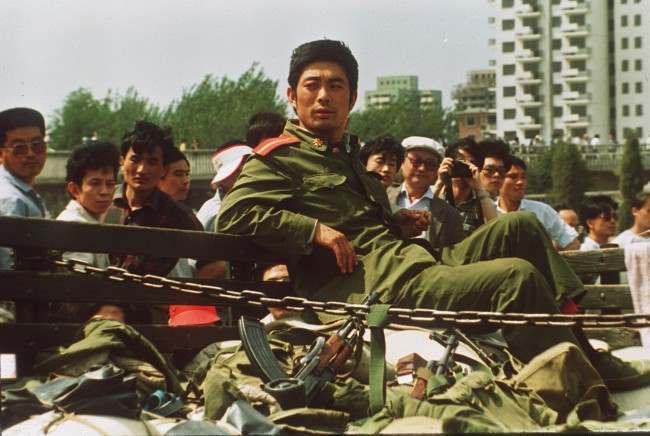
A People’s Liberation Army Soldier sits alone with his weapons Sunday after his convoy was stopped by demonstrators seen in the background. (AP Photo/1989)
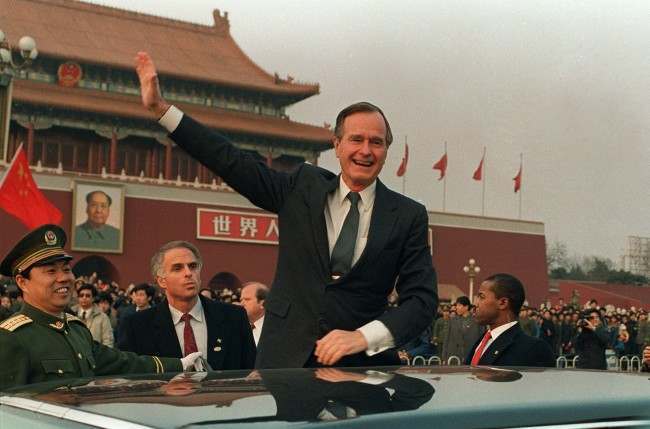
President Bush stands on his car and waves in Tiananmen Square in Beijing during a visit to China in this Feb. 25, 1989 photo. On the wall in the background is a portrait of Mao Tse-tung at the entrance to the Forbidden City. Now that the elder Bush’s son is about to become President George W. Bush, the Chinese are uneasy. While campaigning, George W. Bush and his foreign policy advisers asserted U.S. interests in ways China finds threatening. (AP Photo/Doug Mills, File)
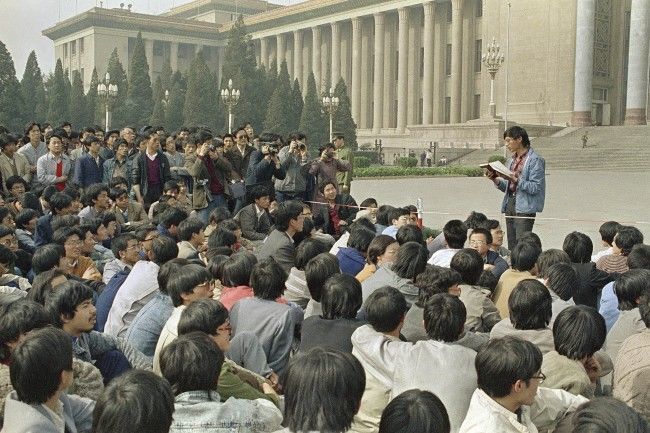
In this April 18, 1989 file photo, a Chinese student leader reads a list of demands to students staging a sit-in in front of Beijing’s Great Hall of the People. A quarter century after the Communist Party’s attack on demonstrations centered on Tiananmen Square on June 4, 1989, the ruling party prohibits public discussion and 1989 is banned from textbooks and Chinese websites. (AP Photo/Kathy Wilhelm, File)
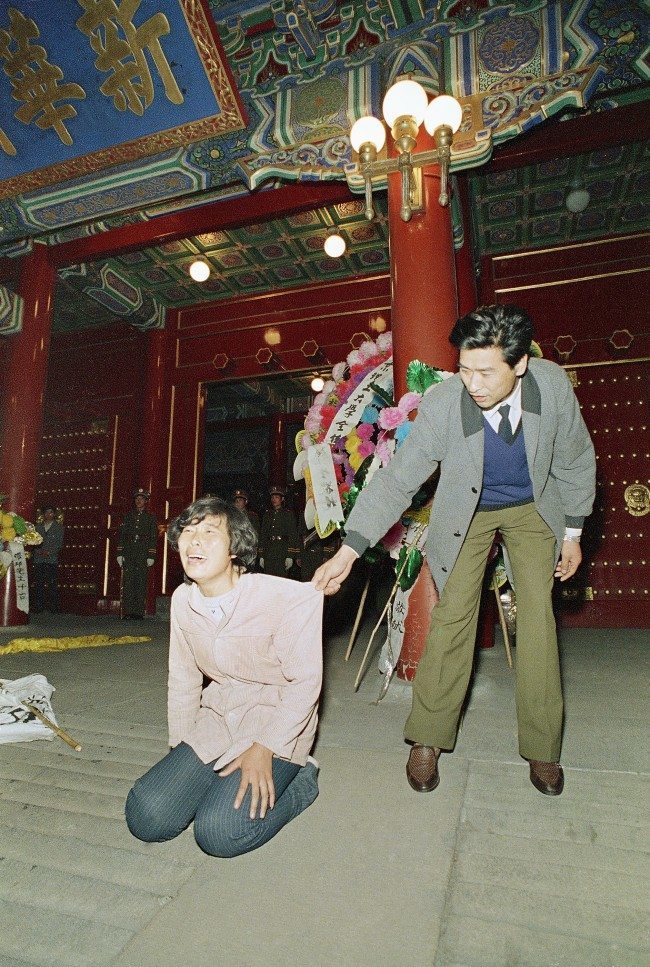
A Chinese security guard gently tries to move a weeping young woman away from the ornate entrance to the Chinese Communist Party headquarters, Zhongnanhai, early on Wednesday, April 19, 1989 in Beijing. University students converged on Zhongnanhai after demonstrating in Tiananmen Square all day on Tuesday. The students tried to storm the gate, but were fought back by Chinese security. (AP Photo/Mark Avery)
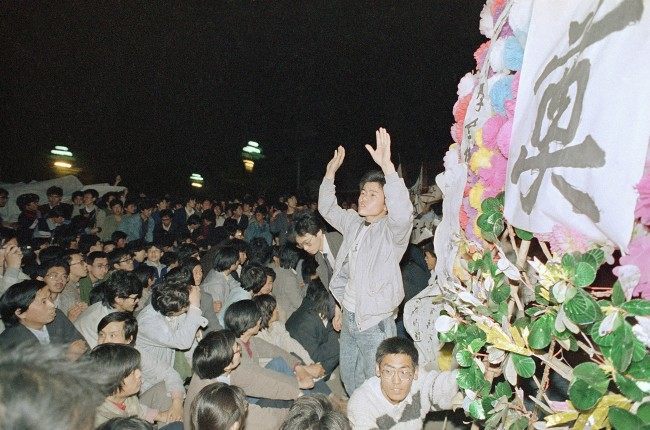
A student leader tries in vain to settle down a crowd of Beijing University students who converged on the Chinese Communist Party headquarters at Zhongnanhai early on Wednesday, April 19, 1989 in Beijing after demonstrating in Tiananmen Square all day on Tuesday. The students later tried to storm the gate, but were fought by Chinese security. (AP Photo/Mark Avery)
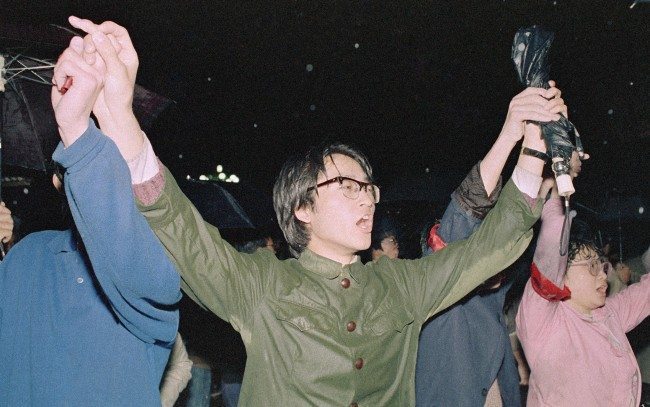
University students hold hands as they sing the Chinese National Anthem during a protest, April 21, 1989 in Beijing’s Tiananmen Square. (AP Photo/Mark Avery)
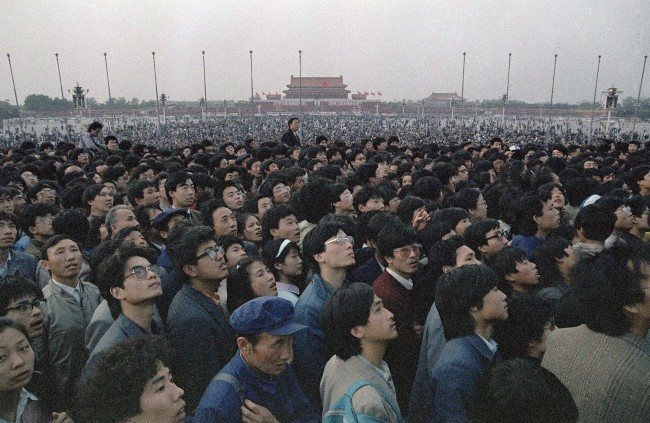
Tens of thousands of students and citizens crowd at the Martyr’s Monument at Beijing’s Tiananmen Square, April 21, 1989. (AP Photo/Sadayuki Mikami)
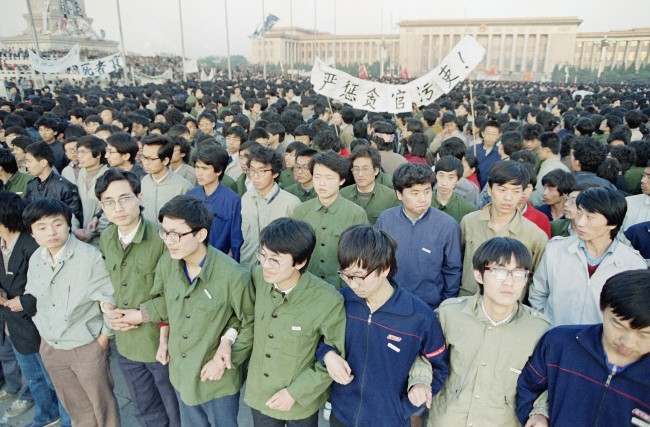
Chinese students link arms in solidarity at dawn on Saturday, April 22, 1989 in Beijing’s Tiananmen Square after spending the night there in order to be on hand for memorial services for the late purged party chief Hu Yaobang. The students defied warnings against demonstrating and gathered by the tens of thousands forcing officials to back down and allow them to stay. (AP Photo/Sadayuki Mikami)
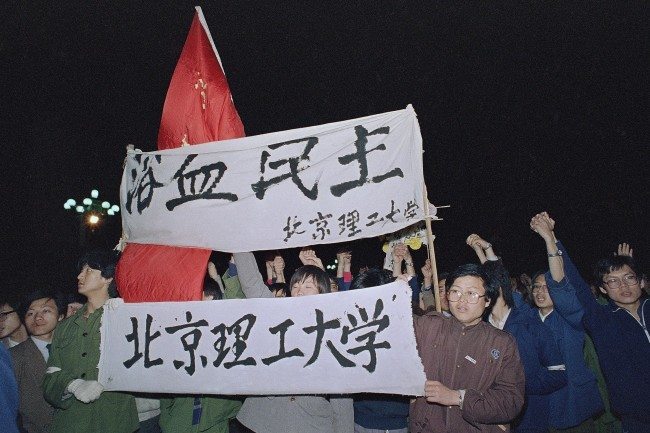
Students from Beijing University of Engineering carry a banner, top, reading ‘Democracy, Bathed in Blood,’ as they march into Beijing’s Tiananmen Square to join tens of thousands of other students early on Saturday, April 22, 1989. The students plan to spend the night in the square and wait for the funeral of Hu Yaobang later in the day. (AP Photo/Mark Avery)
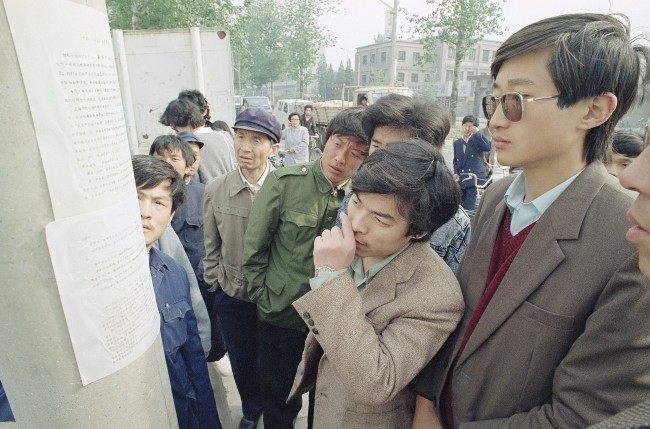
Beijing residents read a copy of a newspaper printed by students and placed on a streetlight pole near the Beijing University campus describing the student demonstrations on Friday and Saturday at Tiananmen Square, April 24, 1989. The student paper, placed on trees and light-posts around the city is an attempt to counter a government imposed news black-out of student demonstrations. (AP Photo/Mark Avery)
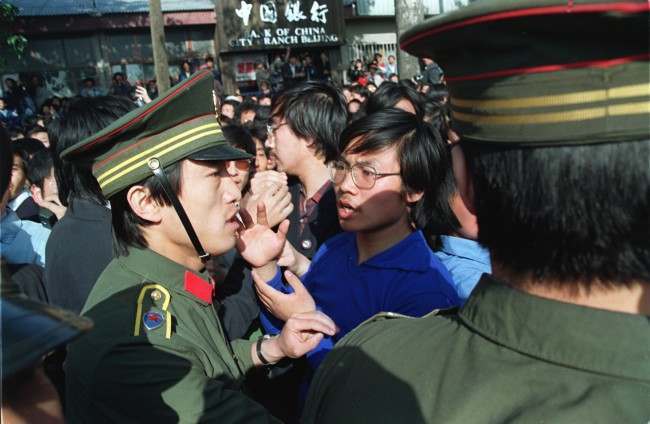
A Beijing University student leader argues with a policeman about the students’ right to march as they are told not to march when emerging from their campus. Students from more than forty universities march to Tiananmen Square in protest of the April 26 editorial in the Communist Party newspaper despite warnings of violent suppression.
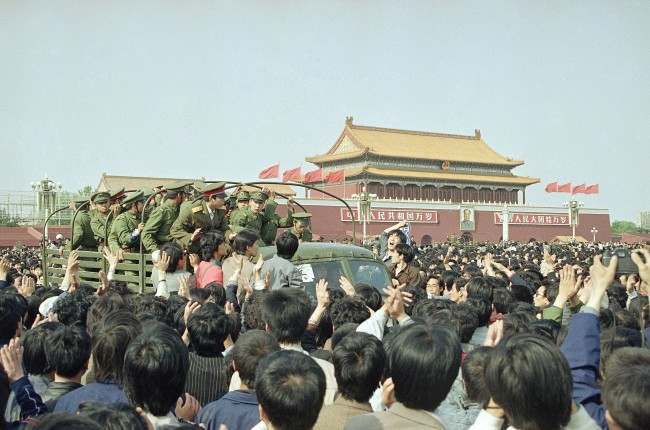
Chinese marchers are jubilant as they surround and stop an army truck at Tiananmen Square, April 27, 1989 in Beijing. (AP Photo/Mark Avery)
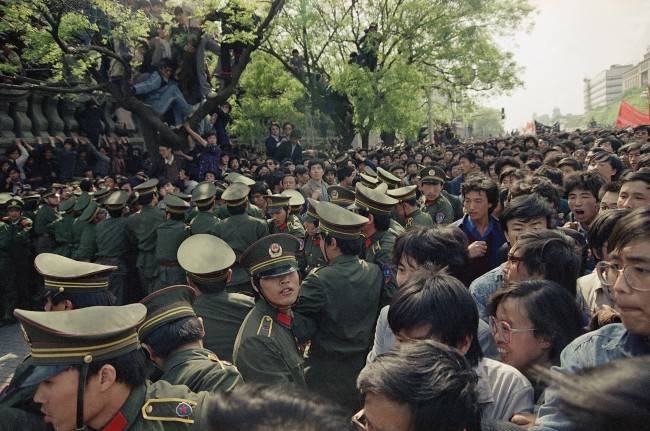
Students demonstrators scuffle with police as they try to break the guard line to march to the Tiananmen Square on Thursday, April 27, 1989 in Beijing. (AP Photo/Sadayuki Mikami)
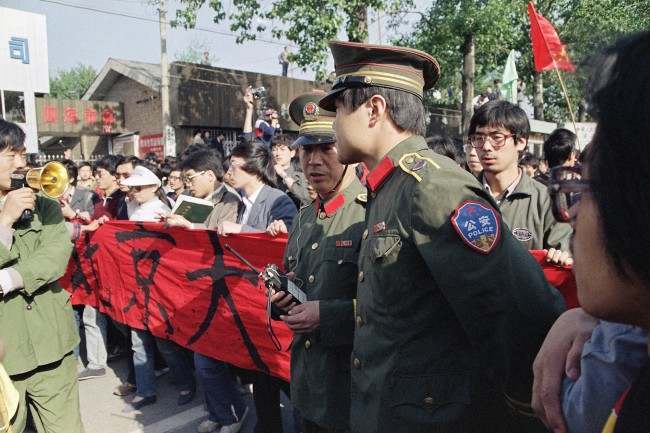
Chinese police try in vain to convince students from Beijing University not to march as they emerged from their campus on Thursday, April 27, 1989 in Beijing. The students from several Beijing universities began a planned march to Tiananmen Square on Thursday in defiance of a government demand they end their campaign for political reform. (AP Photo/Mark Avery)
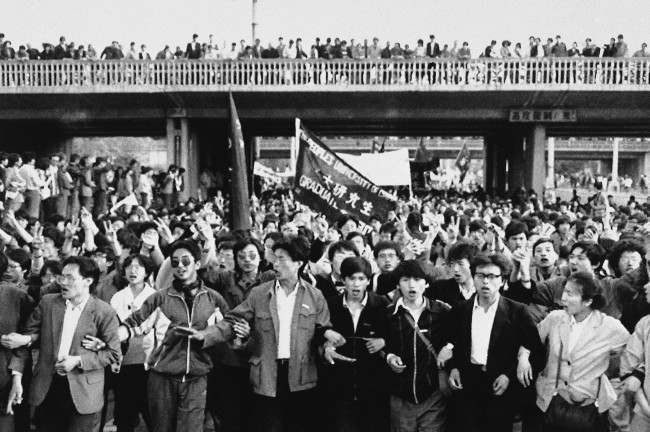
Jubilant student marchers, arms lined, pass under a bridge lined with local supporters, Thursday, April 27, 1989, Beijing, China. Students in the ten of thousands from several Beijing schools demonstrated in defiance of a government ban. (AP Photo/Mark Avery)
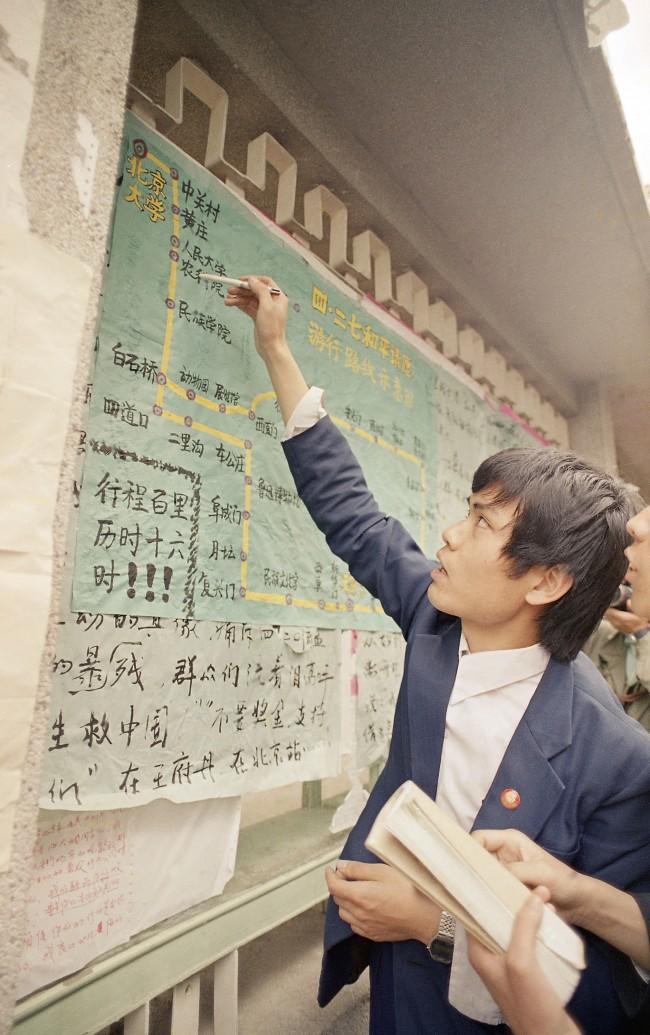
A student at Beijing University points to a map of the march route on a poster up on campus as he recounts a tale of how marchers pushed through police lines on their way to Tiananmen Square, April 28, 1989. (AP Photo/Mark Avery)
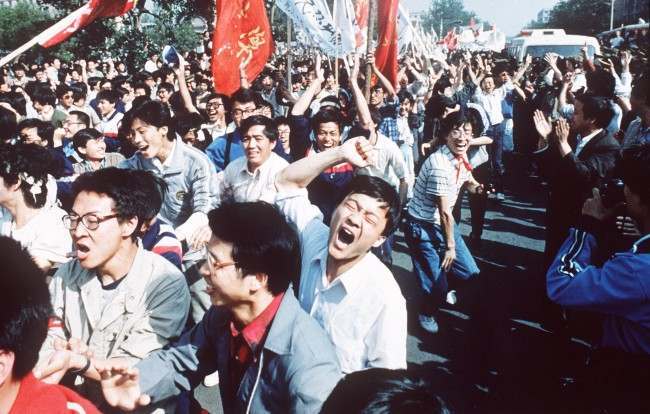
Chinese students shout after breaking through a police blockade during a pro-democracy march to Tiananmen Square, Bejing, May 4 1989. (AP Photo/S. Mikami)
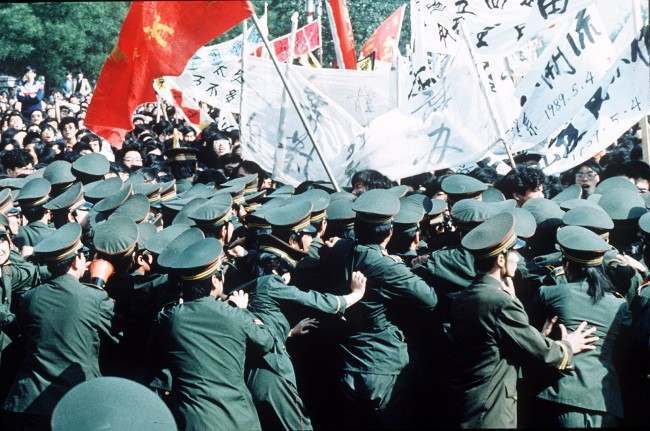
Chinese police try in vain to contain a huge crowd of student marchers during a pro-reform demonstration in Beijing, China, May 4 1989. (AP Photo/S. Mikami)
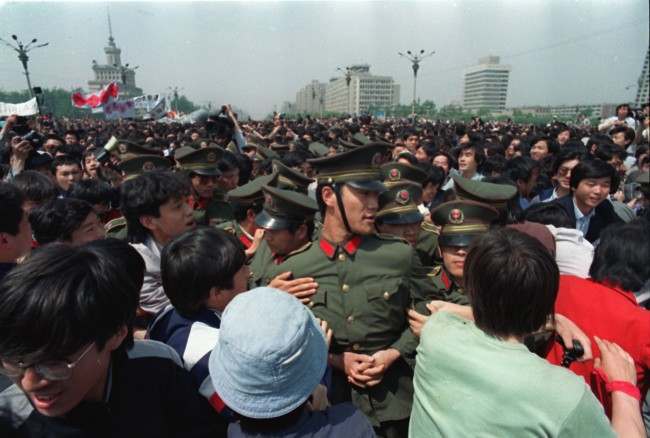
Calling for freedom and democracy, demonstrating students surround policemen near Tiananmen Square in Beijing, China, Thursday afternoon on May 4, 1989. Approximately 100,000 students and workers marched toward the square demanding democratic reforms. (AP Photo/Sadayuki Mikami)
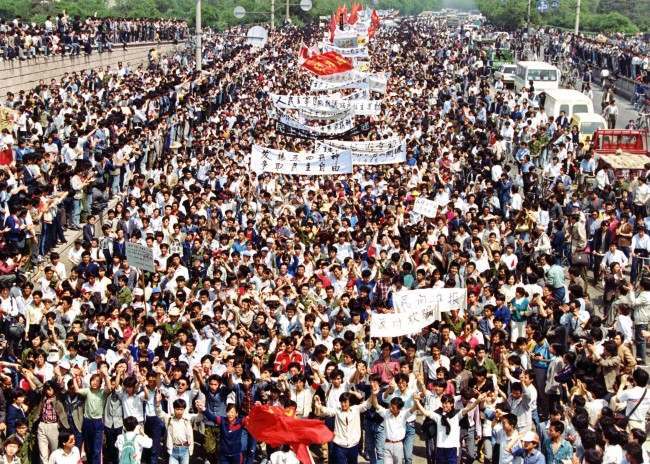
More than seven thousand students from local colleges and universities march to Tiananmen Square, Beijing, May 4, 1989, to demonstrate for government reform. (AP Photo/Mikami)
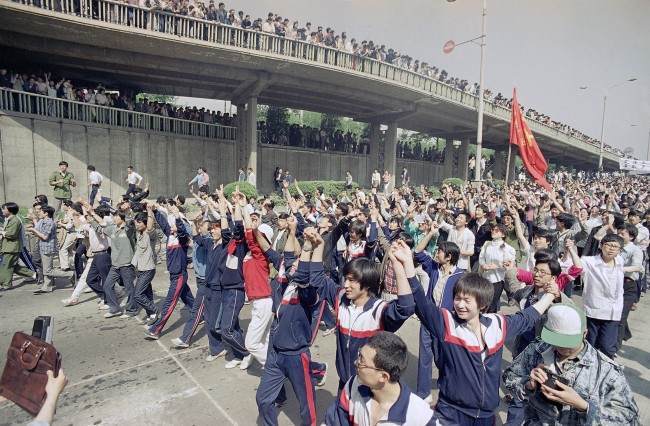
Students of Teachers University raise their hands to appeal to supporting citizens near Tiananmen Square, Thursday, May 4, 1989 in Beijing. (AP Photo/Sadayuki Mikami)
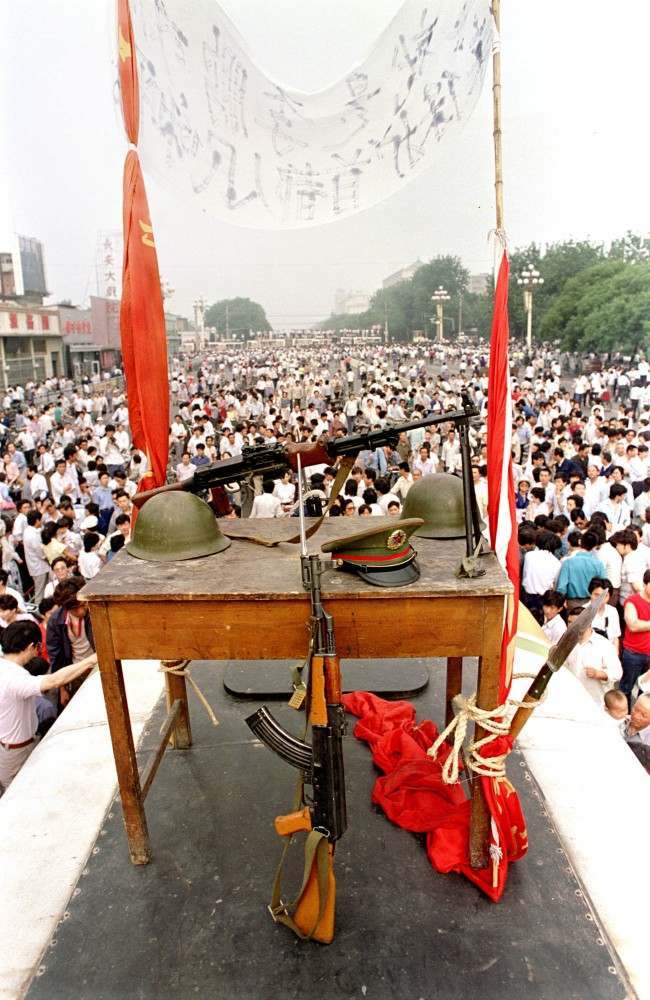
Chinese military items, including rifles, helmets, and a hat, are displayed during the pro-democracy demonstration that lasted from mid-April to early June 1989 on Beijing’s Tiananmen Square. The demonstration ended with a government crackdown on June 4, 1989, leaving hundreds dead. (AP Photo/Jeff Widener)
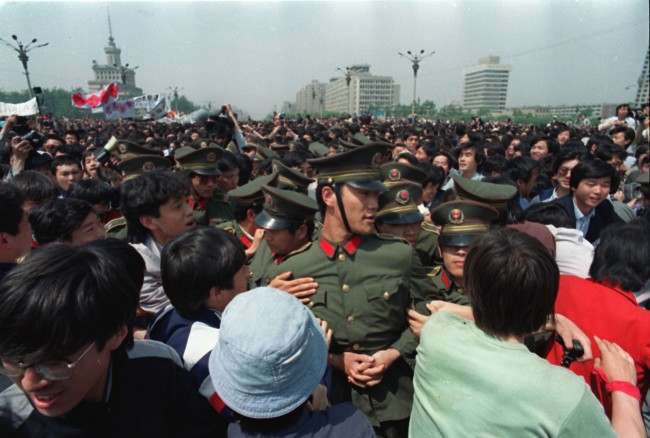
Calling for freedom and democracy, demonstrating students surround policemen near Tiananmen Square in Beijing, China, Thursday afternoon on May 4, 1989. Approximately 100,000 students and workers marched toward the square demanding democratic reforms. (AP Photo/Sadayuki Mikami)
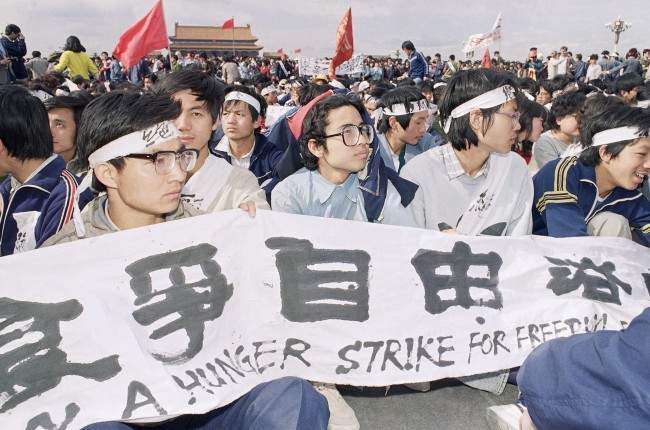
University students sit in Tiananmen Square on Saturday, May 13, 1989 in Beijing on a hunger strike for freedom and democracy. The students vow to sit until the arrival of Soviet leader Mikhail Gorbachev on Monday. (AP Photo)
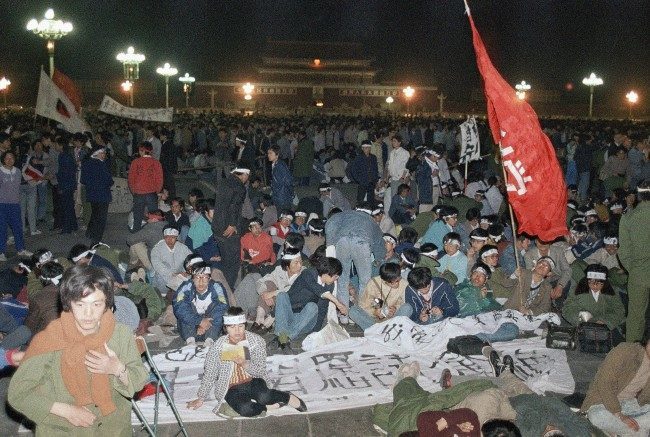
About 3,500 university students from more then a dozen school demand democracy and freedom keep on hunger strike at night, Saturday, May 14, 1989 in Beijing at Tiananmen Square. Students said they would end the hunger strike only when the government agrees to “equal and sincere” talks to their demands. (AP Photo/Sadayuki Miakmi)
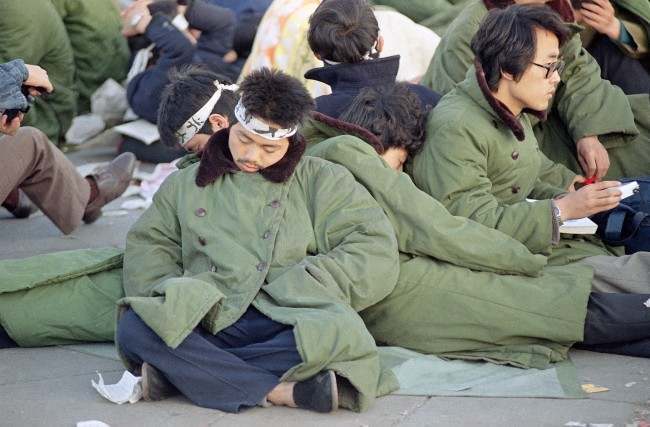
Student protesters in Beijing’s Tiananmen Square sleep leaning on one another at sunrise, Sunday, May 14, 1989 in Beijing. The protesters, some of them on a hunger strike, plan to remain in the square for the official welcoming ceremony for Soviet leader Mikhail Gorbachev on Monday. (AP Photo/Mark Avery)
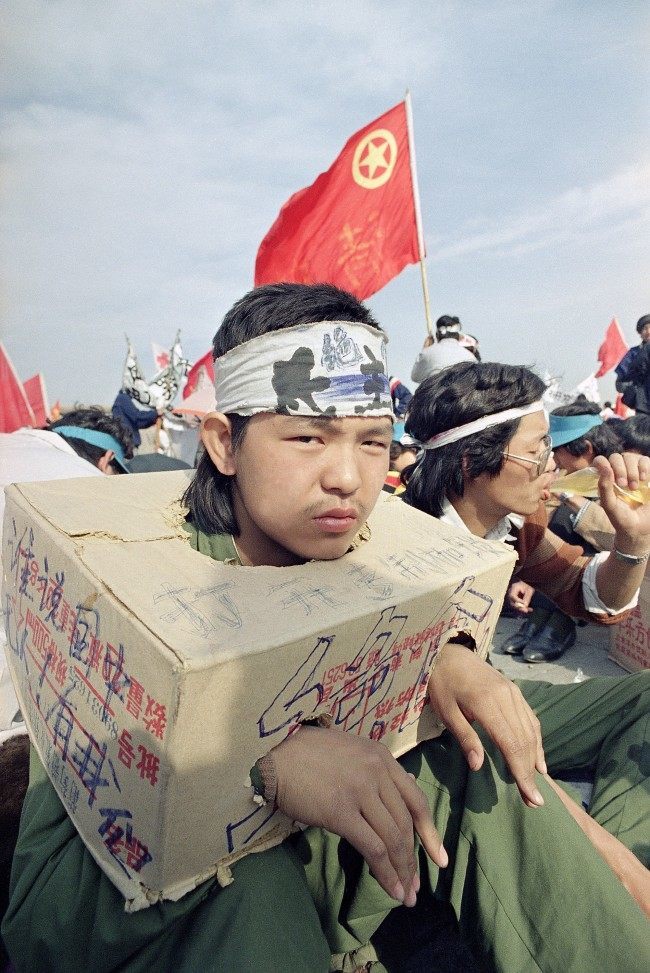
A Beijing university student sits bound in a cardboard box as the strike for democracy continues for the third day in Beijing’s Tiananmen Square, Tuesday, May 16, 1989. The box indicates he cannot use his hands so he cannot eat. (AP Photo/Sadayuki Mikami)
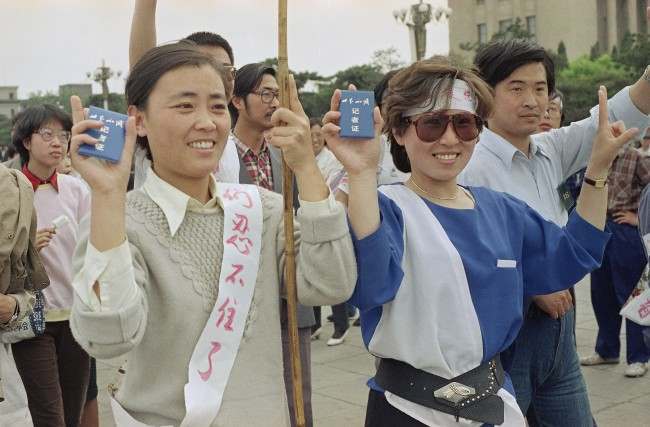
Employees of CCTV, Central China Television, flash their press cards as they join student strikers for democracy in Beijing’s Tiananmen Square at night, Tuesday, May 16, 1989. (AP Photo/ Sadayuki Mikami)
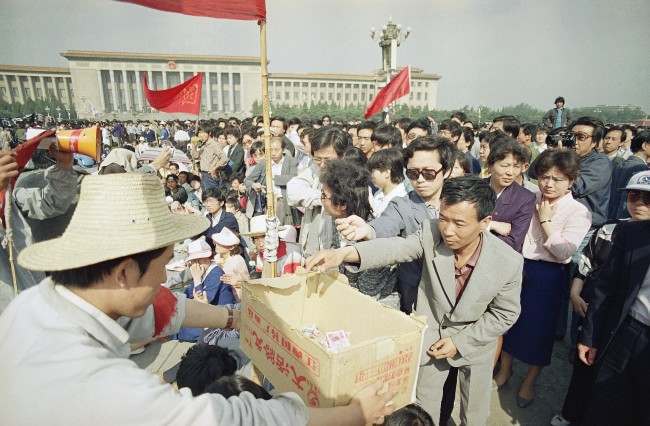
A Beijing University student collects contributions to support the hunger strike from passers by in Beijing’s Tiananmen Square, Tuesday, May 16, 1989. The strike is now is its fourth day. (AP Photo/Sadayuki Mikami)
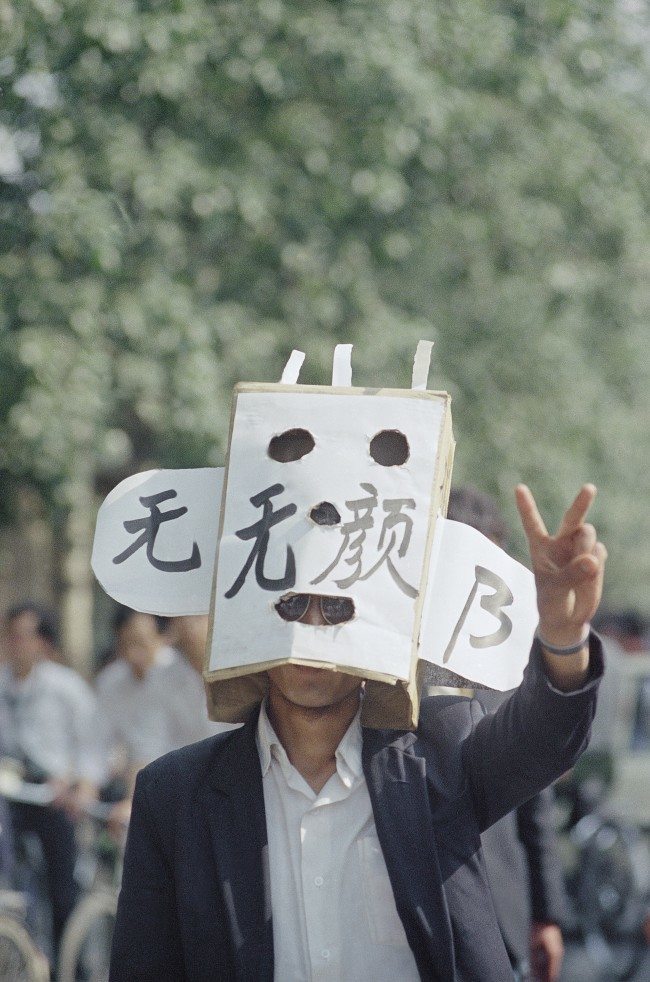
A student protestor flashes a victory sign during a demonstration in Tiananmen Square, Wednesday, May 17, 1989, Beijing, China. The characters on his mask mean losing face. (AP Photo/Mark Avery)
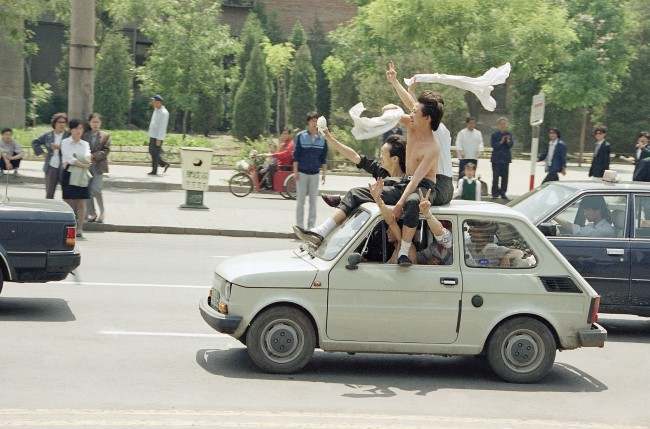
Beijing youths ride atop a car as they parade to Tiananmen Square for a freedom rally, Wednesday, May 17, 1989 in Beijing. (AP Photo/Sadayuki Mikami)
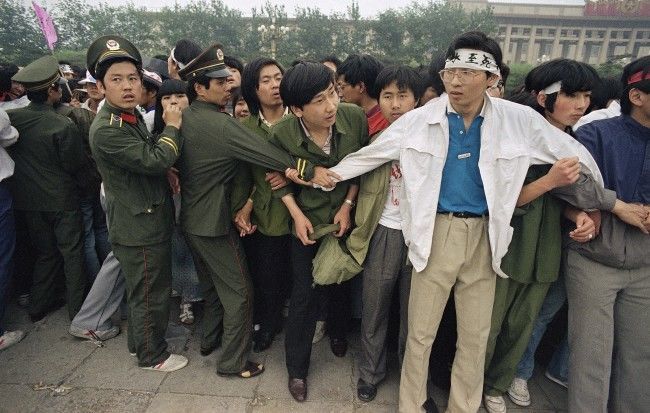
Students and police link area to keep crowd of people, many of the relatives of strikers, from Tiananmen Square, where students have been on hunger strike since Saturday, Thursday, May 18, 1989, Beijing, China. (AP Photo/Sadayuki Mikami)
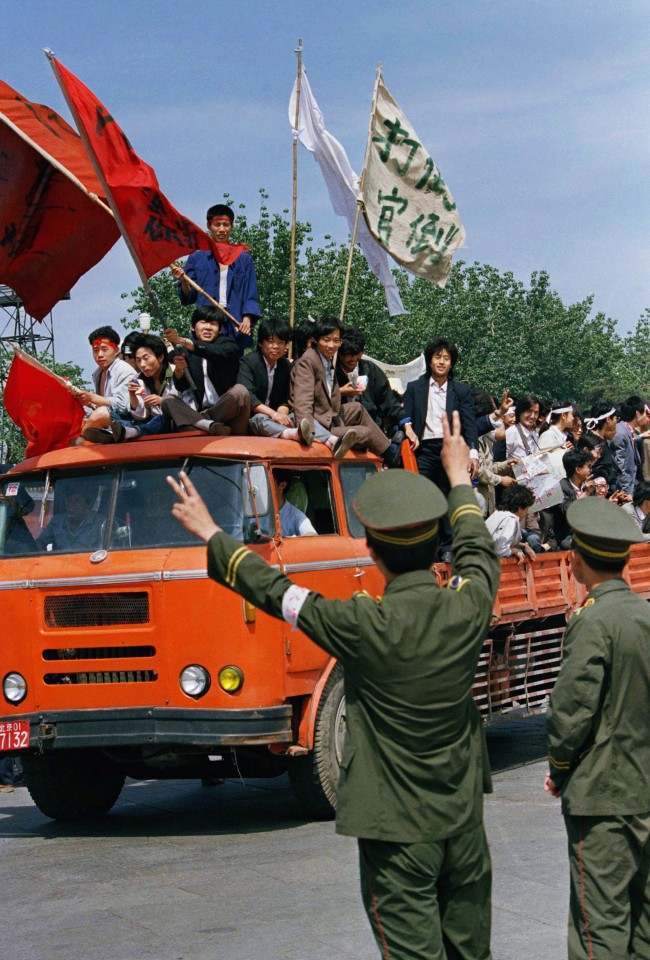
A Beijing policeman encourages university students demonstrating for democratic reforms on Friday, May 19, 1989 in Beijing’s Tiananmen Square. (AP Photo/Sadayuki Mikami)
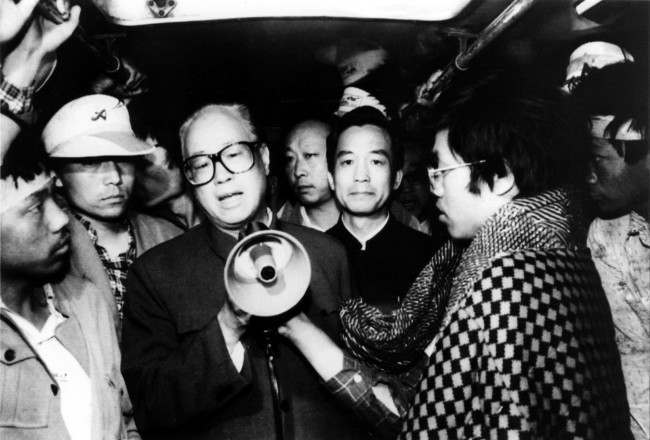
Communist Party General Secretary Zhao Ziyang speaks with fasting university students in Beijing’s Tiananmen Square to urge them to call off their hunger strike. The strike is in its sixth day.
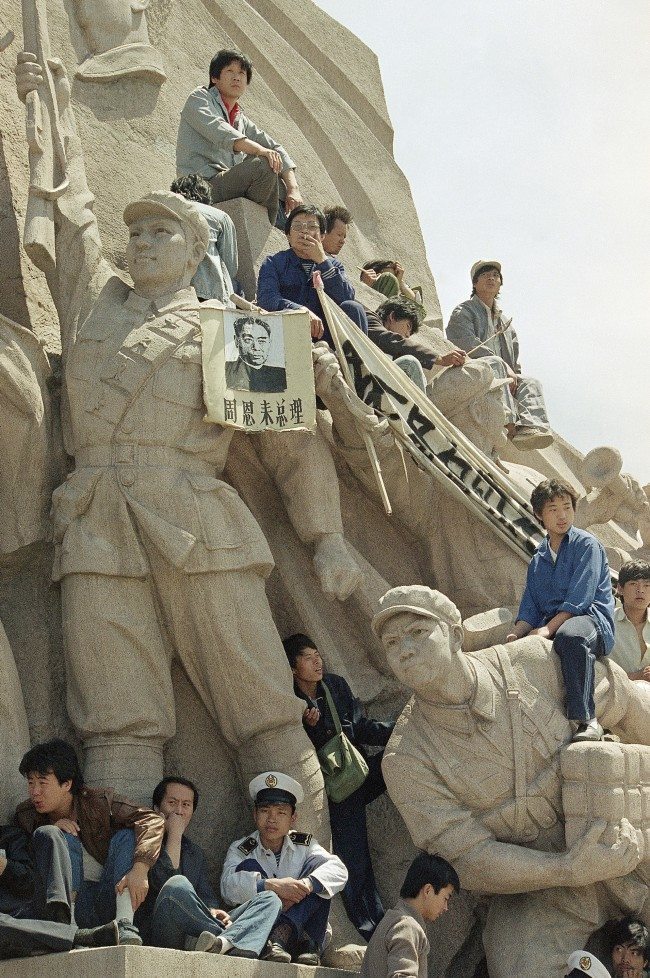
Beijing University students use a monument to the late chairman Mao Tse-Tung at his tomb in Tiananmen Square to press their case for democratic reforms in Beijing, Friday, May 19, 1989. The picture hanging on the statue is the late Premier Chou En-Lai. (AP Photo/Sadayuki Mikami)
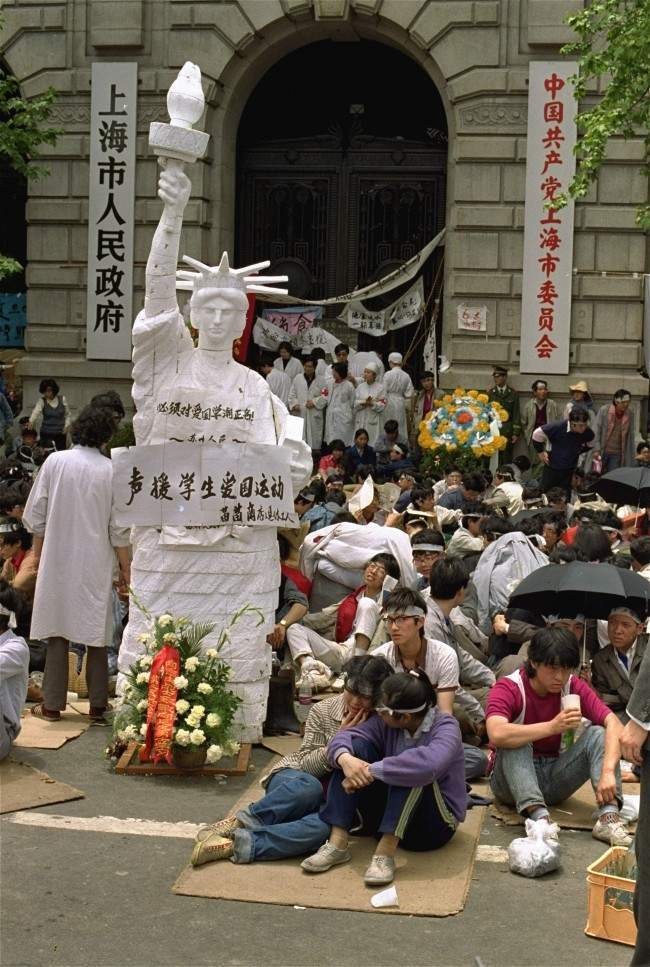
An effigy of the Statue of Liberty stands in front of the Shanghai city government offices as demonstrators rally for democratic reform May 20, 1989. (AP Photo/Mark Avery)
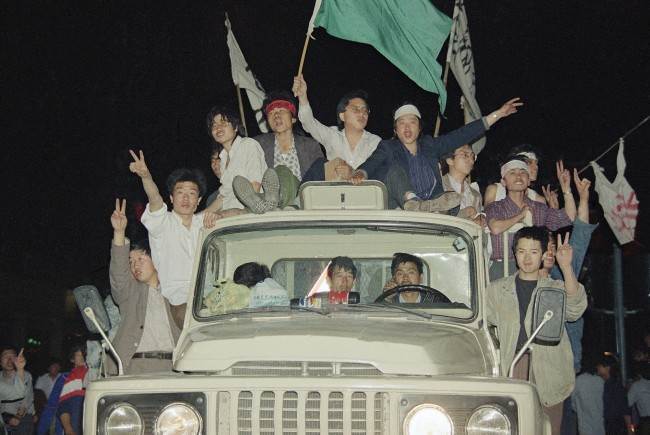
Unidentified demonstrators showing victory signs head to Tiananmen Square, Saturday, May 20, 1989, Beijing, China. (AP Photo/Sadayuki Mikami)
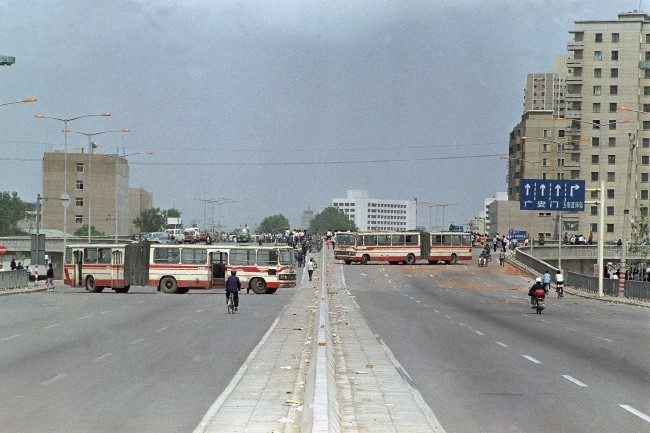
A convey of soldiers from the Peoples’ Liberation Army is completely engulfed by demonstrators who stopped the Tiananmen Square bound troops by blocking the road with the bus in the foreground, May 21, 1989, Beijing, China. (AP Photo/Jim Palmer)
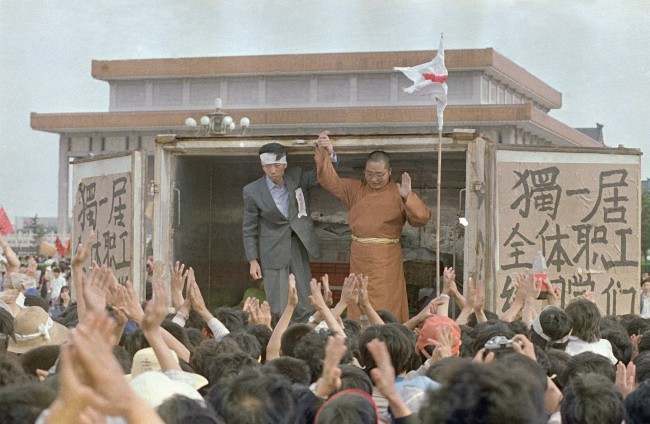
Li Nan, left, of Du Yiju Restaurant, and Yuan Chi, a monk with the China Buddhist Association, receive cheers from students in Tiananmen Square, Sunday, May 21, 1989, Beijing, China. They have donated over $53,000 worth of food to the protestors in the square. (AP Photo/Mark Avery)
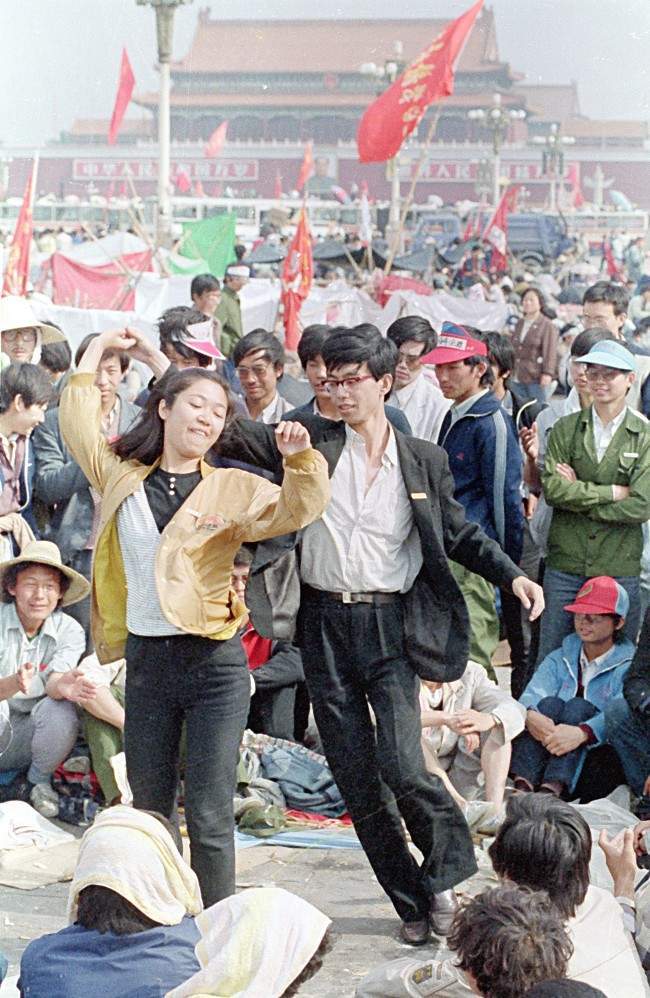
A young unidentified couple, two out of thousands of university students who are holding Tiananmen Square occupied for nine days, pass the time with a lively dance on Monday morning, May 22, 1989 in Beijing, China. (AP Photo/Mark Avery)
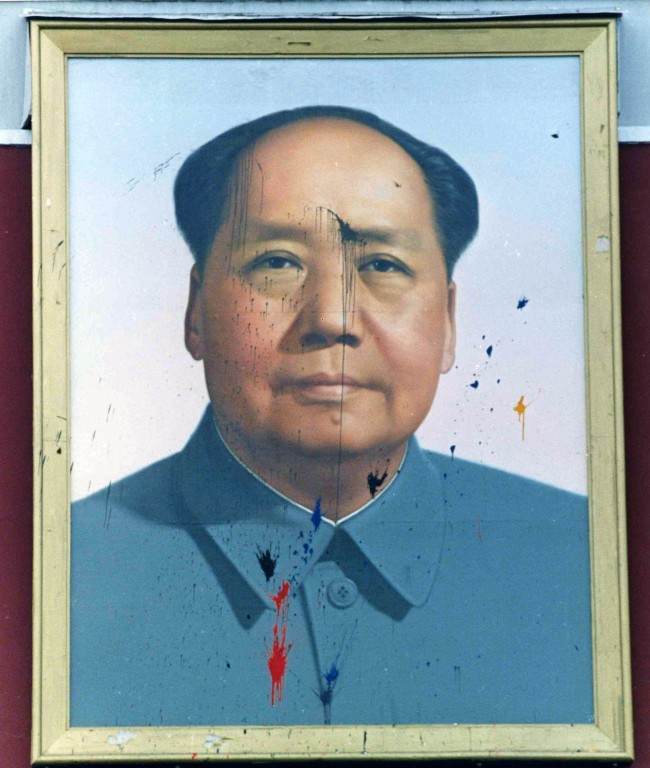
The famous portrait of Chairman Mao looking out over Tiananmen Square, Beijing, from the Forbidden City, May 23, 1989, was spattered with paint during the continuing demonstration in the square. (AP Photo/Avery)
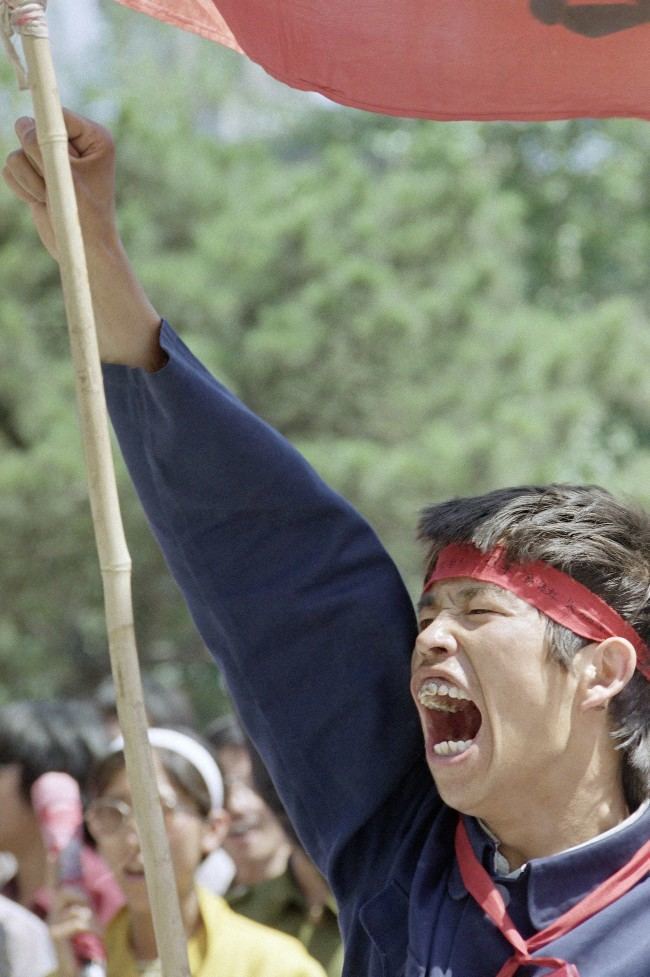
A Beijing University student sounds off during a rally, Thursday, May 25, 1989 in Beijing in Tiananmen Square. (AP Photo/Liu Heung Shing)
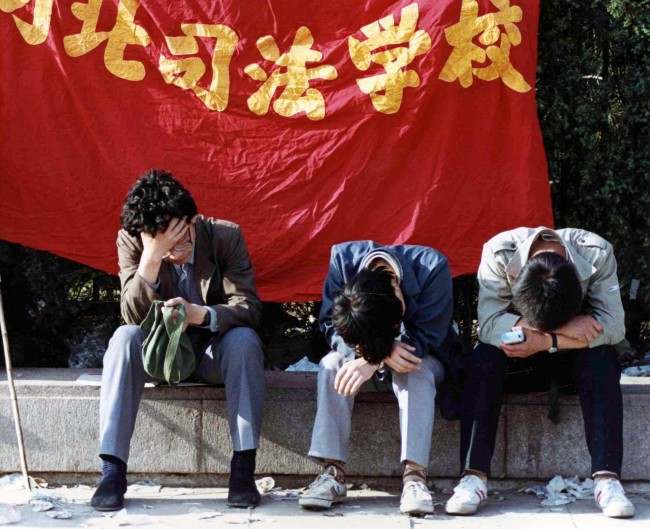
University students rest in Tainanmen Square, Beijing, on May 26, 1989, wher their strike for government reforms is in its 13th day. (AP Photo/Staff/Widener)
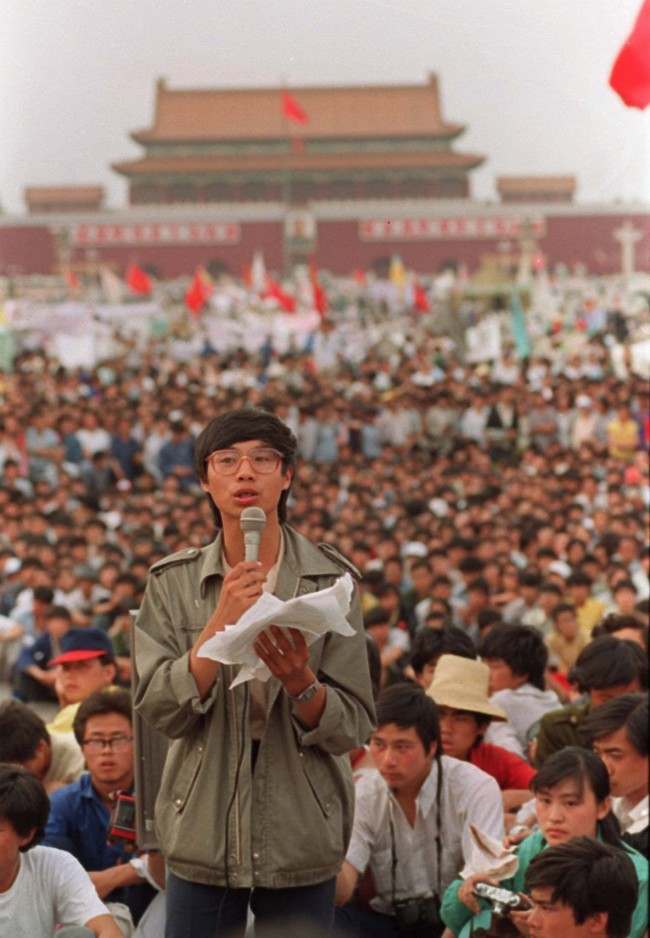
This is a May 27, 1989 photo of student leader Wang Dan in Tiananmen Square Beijing calling for a city wide march. (AP Photo/Mark Avery)
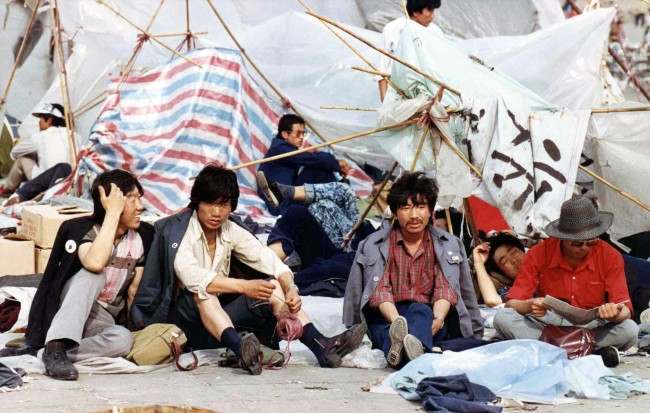
A group of students rest before their tattered tents in Tiananmen Square, Beijing, on May 27, 1989, where thousands of students continue their sit-in protest to press the government for political reforms. (AP Photo/Staff/Widener)
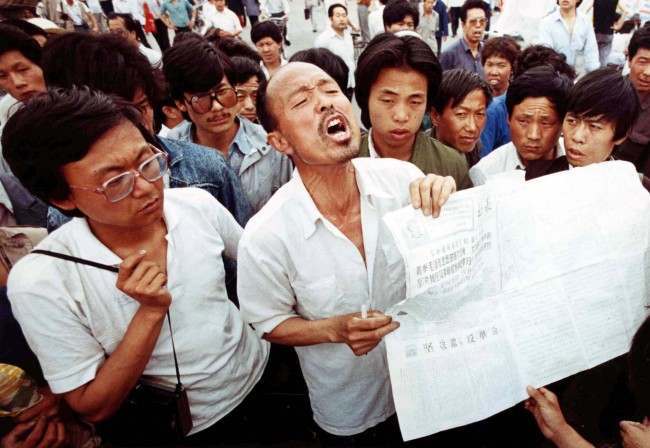
A man who identified himself as a former political prisoner relates his experiences to striking students in Tiananmen Square, Beijing, on May 28, 1989. Students have held the square in a democracy demonstration for more than two weeks. (AP Photo/Staff/Widener)
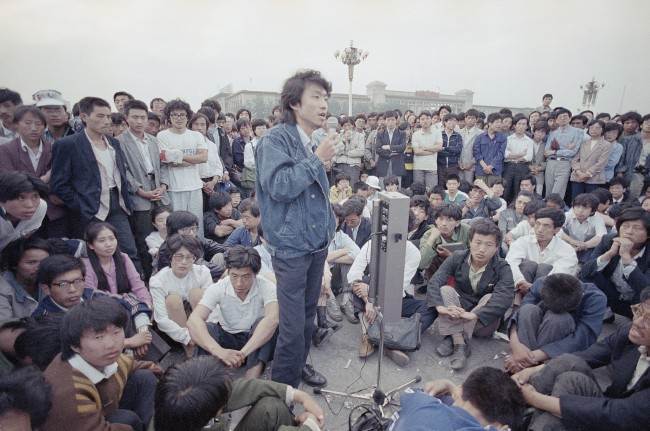
Beijing University students listen as an unidentified strike spokesman details plans for a rally in Tiananmen Square, which they have occupied for the last two weeks, Sunday, May 28, 1989, Beijing, China. (AP Photo/Jeff Widener)
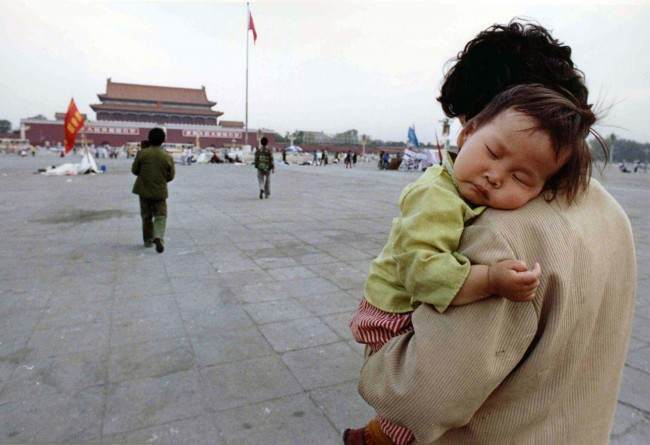
A child sleeps on his mother’s shoulder as she crosses Tiananmen Square, Beijing, on May 29, 1989. Many students have tired and returned to their classes following three weeks of pro-democratic rallies. (AP Photo/Staff/Widener)
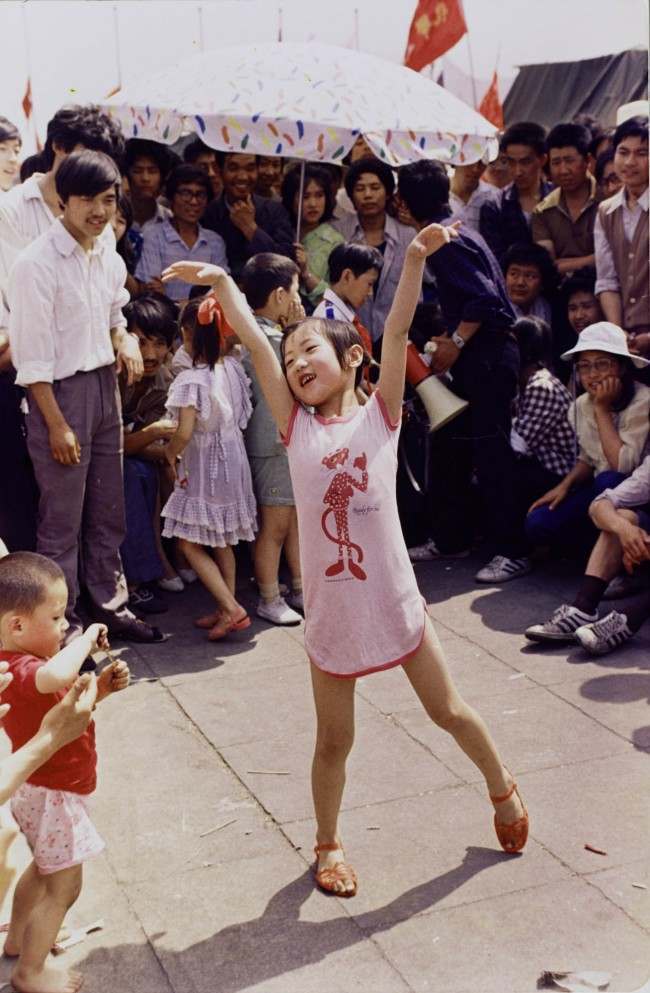
A young Chinese girl dances on Tiananmen Square about June 1, 1989, as pro-democracy protesters continued to occupy the square. Hundreds were killed a few days later in violent clashes between the demonstrators and government troops. (AP Photo/Jeff Widener)
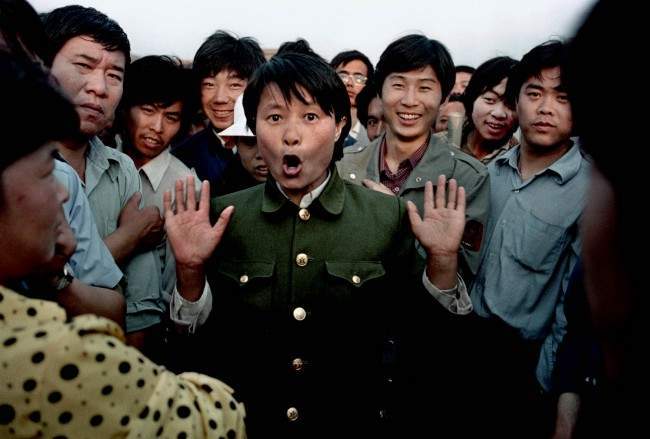
A woman soldier sings among pro-democracy protesters occupying Beijing’s Tiananmen Square, about June 2, 1989. Police and military would occasionally mix with protesters in an attempt to keep the demonstration peaceful. In the early morning hours of June 4, 1989, soldiers overran the square, leaving hundreds dead overnight. (AP Photo/Jeff Widener)
JUNE 3 1989 – The Day Before The Massacre
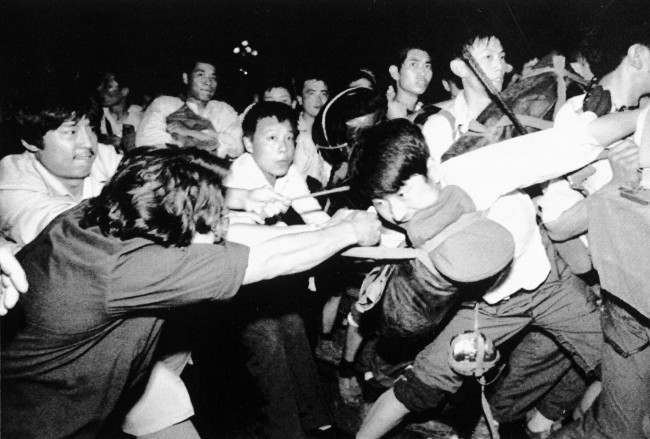
A man tries to pull a Chinese soldier away from his comrades as thousands of Beijing’s citizens turned out to block thousands of troops on their way towards Tiananmen Square early Saturday morning, June 3, 1989. (AP Photo/Mark Avery)
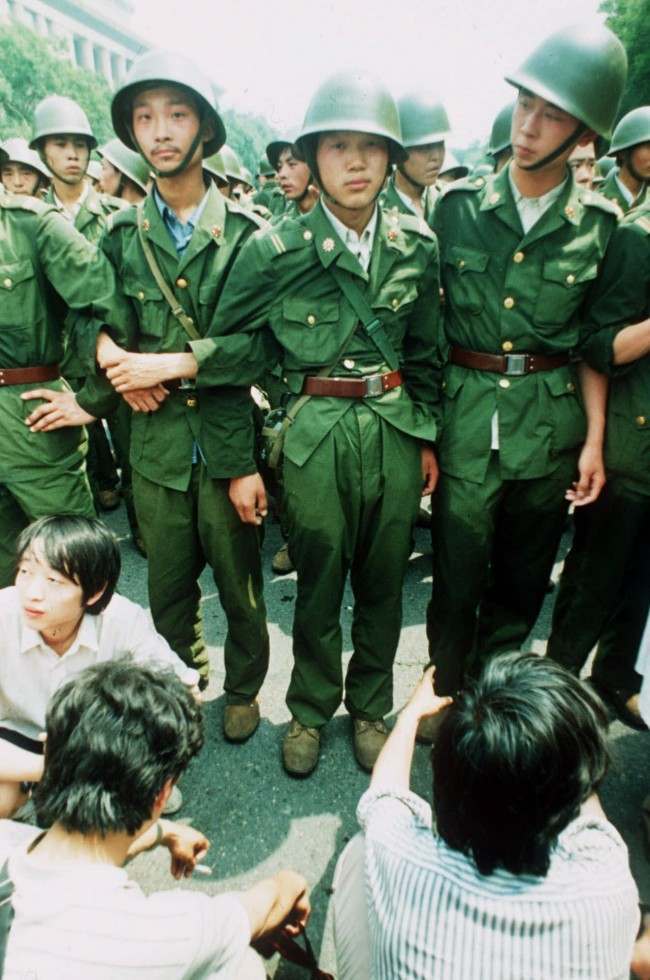
PLA soldiers locked in arms try to march past a human blockade of students outside of the Great Hall of People in this June 3, 1989 photo. Soldiers were reported to resort to teargas and amunitions. On Friday, it will be 10 years since the military assault that killed hundreds and ended seven weeks of protests centered on Tiananmen Square. (AP Photo/Liu Heung Shing)
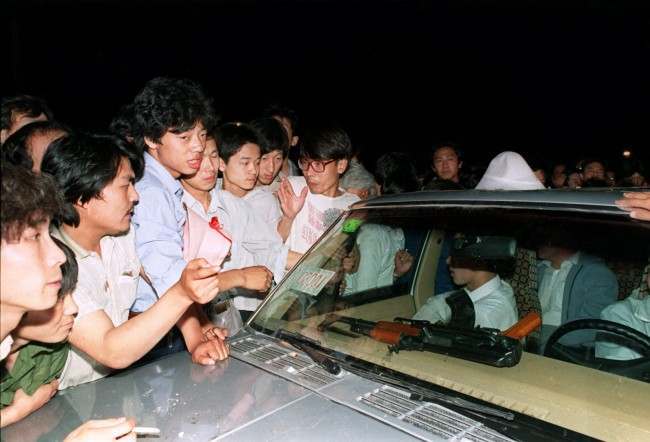
Beijing residents ask soldiers what they were going to do with the machine gun on their dashboard as they surround and stop a carload of chinese soldiers on their way towards to Tiananmen Square in this June 3, 1989 photo. Friday June 4, 1999 is the 10th anniversary of the military assault on pro-democracy protesters who had occupied the square for seven weeks. Hundreds died in the early hours of June 4, 1989 when troops shot their way through Beijing’s streets to retake the square. (AP Photo/Mark Avery, File)
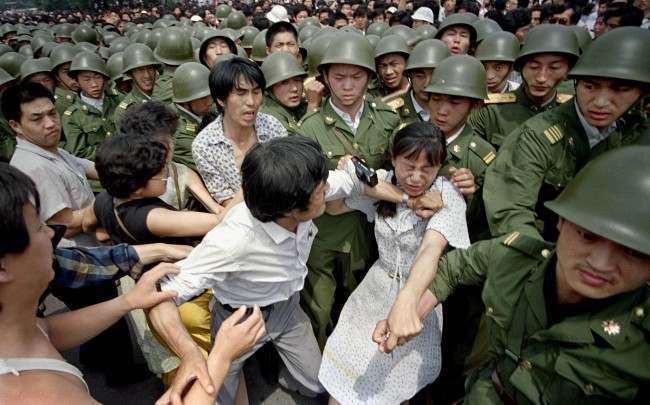
A young woman is caught between civilians and Chinese soldiers, who were trying to remove her from an assembly near the Great Hall of the People in Beijing, June 3, 1989. Pro-democracy protesters had been occupying Tiananmen Square for weeks. (AP Photo/Jeff Widener)
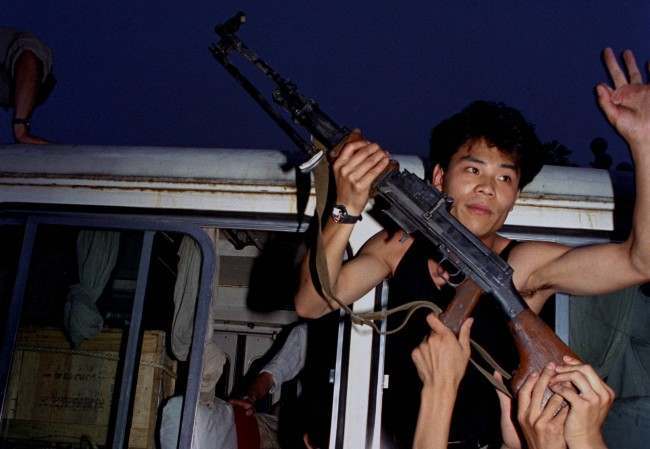
An anti-government protester in Beijing holds a rifle in a bus window, June 3, 1989. Pro-democracy protesters had been occupying Tiananmen Square for weeks; hundreds died that night and the following morning in clashes with Chinese troops. (AP Photo/Jeff Widener)
Beijing is on lockdown as tomorrow’s 25th anniversary of Tiananmen Square approaches:
Government control and interference is evident every year around the anniversary. China has referred to June 4 as “Internet maintenance day,” taking so many sites down for “fixes” that it is unclear which sites are being targeted with restrictions, reports The Washington Post. But this year, the crackdown has reached new levels.
Amnesty International reports arrests and detentions have been on the rise. Scores of activists, lawyers, students, academics, and relatives of those killed in 1989 have been detained, put under house arrest, or questioned, reports Time. Security around the public square has been so strict that tourists have had security officials bar them from the grounds, reports Time. Google services – including Gmail and translation services – have been interrupted since late last week, reports Bloomberg.
Lily Kuo remarks on how successfully the Chinese government has erased the events of June 4, 1989 from the collective memory:
[C]ontrary to what some activists might have hoped, the state-mandated erasure of the incident has been extremely effective. Only 15 out of 100 university students in Beijing recognize the iconic picture of “Tank Man” a demonstrator blocking the path of a line of tanks, according to The People’s Republic of Amnesia, a new book on the topic by NPR correspondent Louisa Lim. …
Scouring the Chinese internet for references to June 4 has become an annual event for the government’s censors, but this year’s efforts have gone further than ever before. All Google services in China, including gmail, are now being blocked on the mainland. … As in previous years, even circuitous mentions of June 4 on social media—including the Chinese characters for six and four together, for the date of June 4, the search term “four, open fire” or “25 years“— are being swiftly deleted by censors. China’s version of Wikipedia, Baike, has no entry for the entire year of 1989.
An anonymous Tea Leaf Nation contributor explains why the Internet has not made it any easier for Chinese youth to talk about the crackdown:
The immense interest among those jiulinghou [Chinese children of the 90s] who are in the know has not translated into active discussion, let alone action. Not all of us think it was wrong to use force against the protesters. And we certainly do not all think China should adopt Western-style democracy. But whatever our views are, we dare not openly discuss them online, in public forums, or even in private chats. And since the Internet is where my generation goes to communicate, we are essentially deprived of the chance to engage in civil discourse.
The Internet has chilled an honest reckoning with Tiananmen, not enabled it. While the web has given rise to a level of pluralism China has never seen before, and minted new, grassroots opinion leaders, it has also made everything we write, both in public and in private, more easily surveilled. Before the digital era, officials didn’t have the ability to eavesdrop on every conversation. But now, if I post something politically sensitive online, the conversation is digitally recorded. Everything becomes part of our permanent record.
But Ellen Bork suggests that “China’s communist leaders may find their efforts to suppress memory backfire”:
According to Min Xin Pei, a scholar of totalitarian transitions at Claremont McKenna College, half of China’s population was born after 1976. They don’t remember the chaotic and violent Cultural Revolution in which millions were sent to perform manual labor in the countryside, as marauding Red Guards sowed paranoia among family and friends. Might this contribute to a change of rule one day? “The basis of rule of all authoritarian regimes is one simple fact—fear,” Pei told an audience at the National Endowment for Democracy. “A psychological shift can come very very quickly.” What that shift will bring, no one can say for sure. But the world will have had at least 25 years to prepare for it.
Meanwhile, Heather Timmons contrasts the mainland’s information blackout with the scene in Hong Kong, where the event is well remembered:
Hong Kong is gearing up for its annual candlelight vigil to mark the anniversary, which is expected to attract more than 150,000 people. Local universities are sponsoring exhibitions and talks by witnesses and journalists (including the “Tank Guy” photographer). The Foreign Correspondents Club is screening a documentary featuring interviews with witnesses and journalists who covered the protests.
On a more personal scale, hundreds of groups of Hong Kong families and friends are expected to gather in their homes on the evening of June 4 to commemorate the event. That will include many people from mainland China, tens of thousands of whom have obtained Hong Kong residency since 1989. At the candlelight event, “in recent years we have noticed more people from mainland China,” said Richard Tsoi, the vice-chairman of the Hong Kong Alliance in Support of Patriotic Democratic Movements of China.
Would you like to support Flashbak?
Please consider making a donation to our site. We don't want to rely on ads to bring you the best of visual culture. You can also support us by signing up to our Mailing List. And you can also follow us on Facebook, Instagram and Twitter. For great art and culture delivered to your door, visit our shop.

